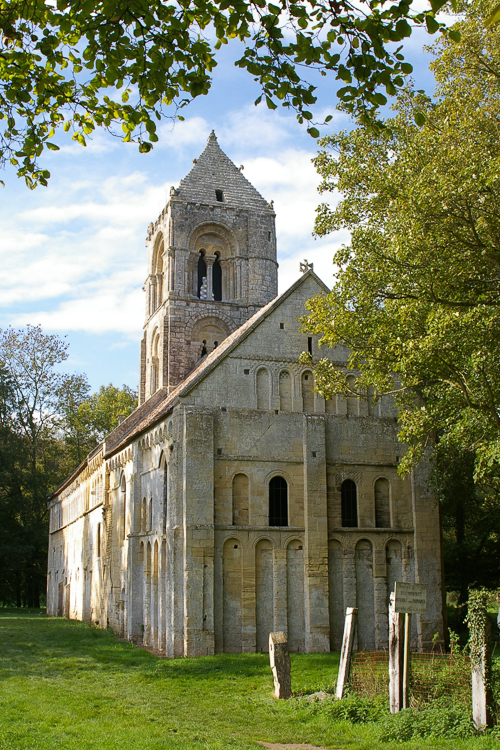Saint Peter's church in Thaon
Thaon's old church, dedicated to Saint Peter, was built in the 11th and 12th centuries, on the banks of the Mue, on the outskirts of the village, in the hamlet of La Vallée. Together with Thaon (Than) Barbières and Bombanville, this hamlet formed the medieval parish.
The seigneury of Thaon depended on the powerful barony of Creully, whose founding ancestor was Hamon le Dentu. In the 12th century, the barons of Creully controlled the entire Bessin region, from the Orne to the Vire. Saint Peter's Church was under the patronage of the chapter of Bayeux's cathedral, which owned large estates in Thaon. The power of the barons of Creully and the notoriety of this patronage undoubtedly explain the architectural quality of the old church.

The church comprises a choir, a central tower and a nave, which originally had side aisles :
- - the oldest elevation is the bell tower, built between 1087 and 1090 which rests on four powerful columns. This is the only surviving elevation of an earlier, narrower Romanesque church built at the same time, as revealed by archaeological excavations ;
- - the choir with its flat radiating chapel, slightly offset to the south in relation to the axis of the bell tower, and the nave were built in the second quarter of the 12th century, after the first Roman sanctuary had been demolished ;
- - the nave, with its five bays, had side aisles that were destroyed at the turn of the 17th and 18th centuries. The layout has been restored thanks to archaeological excavations.


Thaon's old church has preserved its original appearance, with modillions, checked pattern decoration (to the south and on the gable walls) and capitals whose sculptures are reminiscent of those found on the great construction sites in Bayeux and the Trinity in Caen. Clearly the church in Thaon benefited from the skills of the artists who worked on these neighboring sites.
In the 13th century, large Gothic windows were opened on the south side to bring more light into the choir. In the late 17th or early 18th century (shortly before 1729, according to parish records), the side aisles were demolished and the large arcades were completely walled in. During the 18th century, in order to combat the dampness of the area which had become marshy due to the construction of mills on the course of the Mue, the floor level of the church and cemetery was raised by some eighty centimeters. In 1771-1772, the church underwent a restoration campaign, including the rebuilding of the western portal.

From the early 19th century onwards the church attracted the interest of French and English antiquarians and archaeologists, who devoted a number of studies to it. Considered a masterpiece of Romanesque art, it was listed as a historic monument in 1840, the same year that worship was transferred to the new church. Restoration work carried out between 1896 and 1902 extricated the capitals embedded in the masonry and refurbished the 15th century framework as well as the roof. From 1994 to 1999 a new restoration campaign was launched : the bell tower, which had fallen into disrepair, was completely restored, as were the framework and the roofing of the choir and nave.


Archaeological excavations carried out between 1998 and 2011 revealed an ancient cult site (fanum) linked to a nearby ford over the Mue river. During the 4th or 5th century, a small necropolis developed around the ancient sanctuary, leading to the installation of a memoria. The first Christian cult building was attested in the 7th century, then replaced by a new church at the turn of the 7th to 8th centuries. Modifications were made during the Carolingian period to adapt the building to changes in liturgy. Around 1087-1090, the first Romanesque church was built on a cruciform plan around a three-level bell tower. Apart from this, the building was completely rebuilt between 1130 and 1150.
Nearly 460 graves dating from the 7th to the 18th centuries have been studied. In addition to its anthropological interest, the excavation enabled us to analyze the evolution of burial practices and identify the different burial spaces.
Traductions
Galerie photos




Pour visiter l'église
Tous les dimanches de juillet et août, des visites sont assurées par les bénévoles de l'AVET, entre 15h00 et 18h30, et toute l'année sur demande.
Adresse postale
Courriel
Association des Amis de la Vieille Eglise de Thaon
Mairie de Thaon
14610 THAON
vieilleeglisedethaon@free.fr





